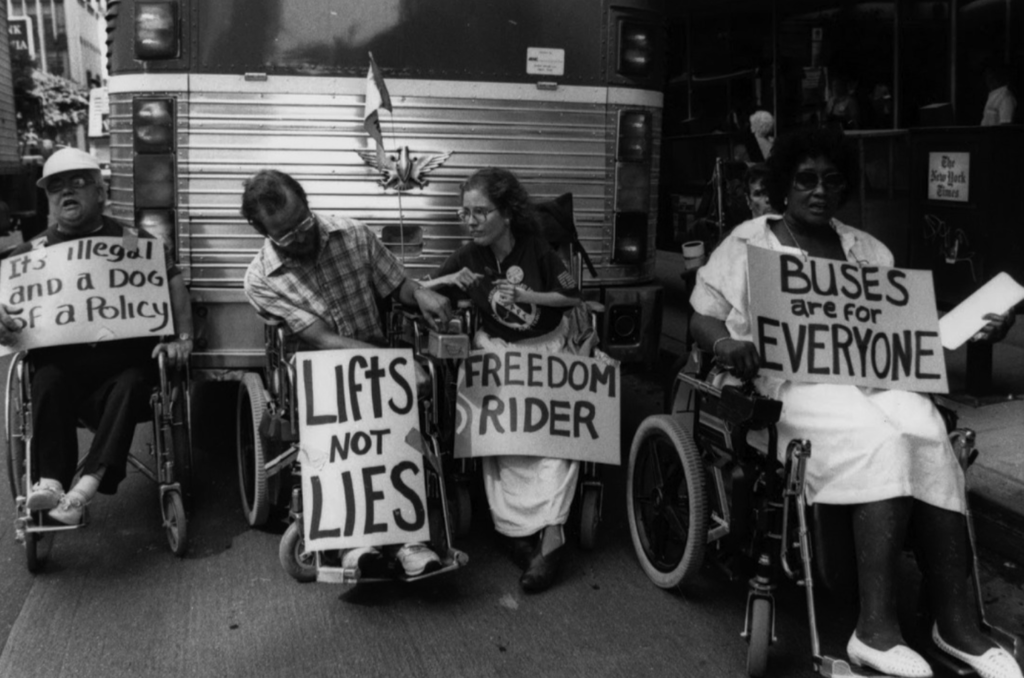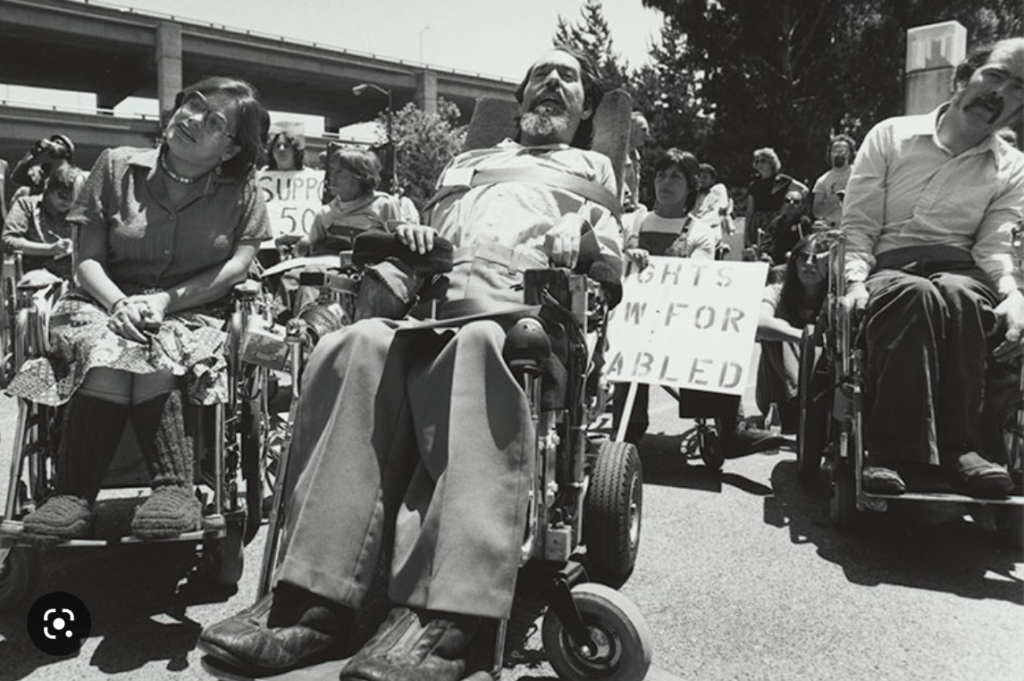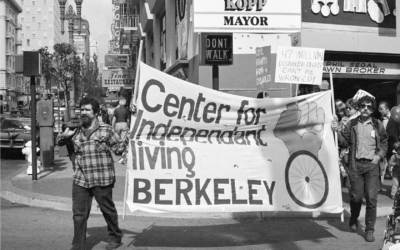The Americans with Disabilities Act (ADA), enacted in 1990, is a landmark federal civil rights law that prohibits discrimination against individuals with disabilities and ensures access to public buildings, businesses, communications, transportation, and employment. Thirty-three years ago this July, the ADA ushered in an era where laws requiring equality and respect for people with disabilities helped shift cultural expectations, marking a milestone not only in equality, but also the treatment of people with disabilities. While we continue to work towards true equality, society has come a long way since then, and we want to celebrate the progress we have made for people with disabilities through this monumental piece of legislation.
Before the ADA

Disability rights activists stage a protest in Los Angeles, California, to bring attention to the inaccessibility of public transit and over-the-road coach companies in the 1970s. Image description: black and white image. Several people in wheelchairs sit in front of a public bus with protest signs. Photo Tom Olin photography.
Before the ADA, individuals with disabilities often faced significant barriers and discrimination in various aspects of life. Society generally viewed people with disabilities as inferior. The dark history of people with disabilities is riddled with abuse and extreme discrimination (read this previous article for more information). For centuries, people with disabilities were often institutionalized away from their families and society, often in horrendous conditions. “Ugly Laws” were passed in the 1800s that made it illegal for people with disabilities who were “unsightly” to be seen in public. Sterilization laws against people with intellectual disabilities still existed as late as 1981 in Colorado.
Public spaces, buildings, transportation systems, and facilities were mostly inaccessible to individuals with disabilities. The lack of ramps, elevators, accessible parking, and accommodations made it difficult for people with mobility impairments to navigate and participate fully in public life. Many public transportation systems did not have provisions for individuals using wheelchairs or other mobility devices.
Individuals with disabilities also faced significant barriers to employment. Discrimination based on disability was common, and people with disabilities often struggled to find and retain meaningful employment. Employers were not required to provide reasonable accommodations, and workplace environments were not always accessible. People with disabilities often faced low expectations and limited opportunities for career advancement.
Passing the ADA
The ADA was first introduced in Congress in 1988 by Senator Tom Harkin and Representative Tony Coelho. Senator Tom Harkin, whose brother was deaf, grew up witnessing the challenges faced by individuals with disabilities. Representative Tony Coelho himself had epilepsy and faced discrimination and barriers in his career. These personal experiences motivated both Harkin and Coelho to address the inequalities faced by people with disabilities. They drew inspiration from previous disability rights laws, such as Section 504 of the Rehabilitation Act of 1973 (learn more in this previous article), which brought about significant changes for people with disabilities by prohibiting discrimination and ensuring equal access to programs and activities receiving federal financial assistance. Section 504 was considered the first to address issues of equality and discrimination towards the disability community. But it was hard-won.

Ed Roberts and Judy Huemann at protests for Section 504. Image description: The photo is in black and white. Ed Roberts sits on the right in a wheelchair. He wears dark pants and a white shirt. Straps are across his torso in multiple places and his head is resting against a pad. To his left is Judy Huemann. She also sits in a wheelchair. She is wearing glasses with shoulder-length hair. She is wearing a button-down collared shirt and a skirt. She has on knee-high knitted boots. Behind them are several other people, some holding signs that say “rights for disabled”
Back in 1972-73, when Section 504 was drafted, the potential costs and increased rights for people with disabilities raised concerns within the Nixon and Ford administrations, leading them to consider rewriting the language and abandoning the law altogether. However, determined individuals with disabilities staged protests, sit-ins, and historic demonstrations on Madison Avenue and in Washington DC. They also filed a lawsuit in 1975, exerting immense pressure on the Office of Health, Education, and Welfare to sign the law. Upon assuming office, former President Jimmy Carter initially pledged his support, but as time went on, he grew cautious and attempted a last-minute alteration, seeking to view people with disabilities as “separate but equal” rather than fully integrated into society. News of this proposed change leaked, triggering the famous 25-day sit-in in San Francisco—an unprecedented act of nonviolent occupation in a federal building, and one that still holds the record as the longest peaceful sit-in. Finally, in 1977, after five years of drafting legislation, overcoming obstacles from various quarters, including three presidential administrations, and enduring attempts to revise or sabotage it, Section 504 was signed into law, marking a significant milestone in the fight for disability rights.
Coelho and Harkin aimed to expand the scope of the protections and address gaps in the existing legislation of Section 504 by creating a comprehensive federal law. The bill underwent several revisions and amendments before being passed by both houses of Congress. The ADA was signed into law by President George H.W. Bush on July 26, 1990.
The Key Provisions of the ADA

President George Bush signs the ADA into Law, July 1990. Image description: George Bush sits at a desk outside. Behind him is a green lawn and fountain. Four other people sit around him. One man to his left is in a wheelchair.
Title I: Employment – Prohibits discrimination against qualified individuals with disabilities in all aspects of employment, including hiring, advancement, and job conditions.
Title II: Public Services – Requires state and local governments to make their programs and services accessible to individuals with disabilities.
Title III: Public Accommodations – Ensures equal access to privately owned businesses that are open to the public, such as restaurants, hotels, and retail stores.
Title IV: Telecommunications – Mandates telephone and internet services to be made accessible to individuals with hearing and speech disabilities.
Title V: Miscellaneous Provisions – Includes provisions related to the ADA’s enforcement and relationship with other laws.
After the ADA passed, some business organizations and industry groups expressed concerns about the potential financial burden and administrative challenges associated with implementing ADA requirements. They argued that compliance costs – retrofitting and new construction to make buildings accessible – could be significant, particularly for small businesses. Some conservatives and proponents of limited government expressed concerns about potential government overreach and burdensome regulations imposed by the ADA. They argued that the ADA could hinder business operations and individual freedom by imposing extensive requirements and mandates.
Though there was some opposition to the ADA, the law also received significant support and is now widely regarded as a critical piece of civil rights legislation. The ADA’s impact and effectiveness in promoting equal rights for individuals with disabilities have been significant and far outweigh the oppositional concerns. Today, almost all public buildings – courthouses, libraries, and so forth – are accessible. Most regional transportation provides accessible ride options; most employers follow equal opportunity employment practices; most colleges and universities, including private ones, provide accessibility and accommodations; and many businesses not only provide accommodations and accessibility but also seek to hire persons with disabilities to cultivate a diverse workforce.
In 2008, the ADA Amendments Act (ADAAA) was signed into law, broadening the definition of “disability” and providing increased protections, ensuring that individuals with disabilities receive the broad protections intended by the law. The ADAAA directed that the definition of disability should be construed broadly to cover a wider range of impairments. Essentially, it expanded the definition of disability to enable more people to qualify for workplace accommodations and have greater recourse against discrimination. It reinforced that employers were not allowed to discriminate against qualified individuals with disabilities. The ADAAA clarified that impairments that are episodic or in remission, such as epilepsy or cancer, are still considered disabilities if they would substantially limit a major life activity when active. However, it also clarified that short-term incapacities, lasting 6 months or less, were not considered disabilities that qualified for protection under the ADA.
The Positive Changes
Since the passage of the ADA in 1990, there have been significant changes and improvements in the lives of people with disabilities. Here are some key ways in which things have changed:
Increased Accessibility
The ADA has led to increased accessibility in public spaces, including buildings, transportation, and communication technologies. Ramps, elevators, accessible parking spaces, and curb cuts have become more common, allowing individuals with mobility impairments to navigate public areas more easily. Public transportation systems have improved accessibility, with buses, trains, and stations designed to accommodate individuals with disabilities. Telecommunication services have become more accessible through the provision of text telephones (TTYs), captioning, and telecommunications relay services as well as screen reading apps.
Employment Opportunities

Image description: Three people wearing orange construction reflective vests sit and look at someone else to the left, who wears a yellow reflective vest. The woman in the front is in a wheelchair.
The ADA has opened up employment opportunities for individuals with disabilities. Employers are prohibited from discriminating against qualified individuals with disabilities and are required to provide reasonable accommodations, such as modified work schedules or assistive technologies, to enable their participation in the workplace. Individuals with disabilities have better access to job applications, interviews, and career advancement opportunities.
Education and Public Access
State and local governments are required to make their programs and services accessible to individuals with disabilities. The ADAAA added the requirement that schools must provide accommodations for students with disabilities even if they are not eligible for services under the Individuals with Disabilities Education Act (IDEA). Public schools have made strides in providing inclusive education for students with disabilities, ensuring they have equal access to educational opportunities. Public facilities, such as parks, libraries, and courthouses, have made efforts to become accessible, allowing individuals with disabilities to participate fully in community life.
Social Attitude
Most significantly, the ADA has helped foster a cultural shift in how disabilities are perceived, promoting inclusivity and awareness. Attitudes towards people with disabilities have evolved, increasing recognition and acknowledgment of their equality, rights, abilities, and contributions to society. Public awareness campaigns, advocacy efforts, independent living centers, and disability rights organizations have played a crucial role in raising awareness and promoting inclusivity.
As we move forward, more work needs to be done. Discrimination is still, unfortunately, a very prominent part of our society, and we will continue to educate and advocate for change to create a more equal and equitable society. In a couple of weeks we will present an article outlining where we envision going from here in terms of laws and social changes that increase equality, equity, and inclusivity. Yet, even with more work to do, it is important to acknowledge how far we have come from the early days of institutionalization and discrimination to now embracing differences as a part of life and building a society that values everyone. For this, we celebrate the passing of the ADA with gratitude for the progress we have made so far.





